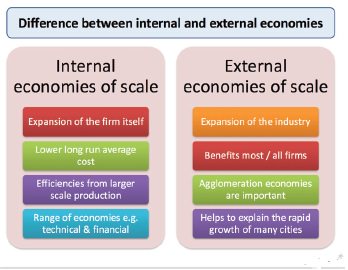Production Analysis | Economics - Economies of Scale | 11th Economics : Chapter 3 : Production Analysis
Chapter: 11th Economics : Chapter 3 : Production Analysis
Economies of Scale
Economies of Scale
‘Scale of Production’ refers to the ratio of factors of production. This ratio can change because of availability of factors. The Scale of Production is an important fact or affecting the cost of production. Every producer wishes to reduce the costs of production. Hence he(he includes she as well) uses an advantage of economy of scale. This economy of scale is effected both by the internal and external factors of the firm. Accordingly, Economies are broadly divided into two types by Marshall.

1. Internal Economies and
2. External Economies
Economies of scale reduces the cost of production: and, diseconomies of scale increases the cost of production.
1. Internal Economies of Scale
‹The term Internal Economies of Scale› refers to the advantages enjoyed by the production unit which causes a reduction in the cost of production of the commodity. For example, a firm enjoying the advantage of an application of most modern machinery, generation of internal capital, an improvement in managerial skill etc. are sure to reduce the cost of production. They are of various types:
Technical Economies : When the size of the firm is large, large amount of capital can be used. There is a possibility to introduce up- to-date technologies; this improves productivity of the firm. Here research and development strategies can be applied easily.
Financial Economies: Big firms can float shares in the market for capital expansion, while small firms cannot easily float shares in the market.
Managerial Economies: Large scale production facilitates specialisation and delegation.
Labour Economies: Large scale production implies greater and minute division of labour. This leads to specialisation which enhances the quality. This increases the productivity of the firm.
Marketing Economies: In the context of large scale production, the producers can both buy raw- materials in bulk at cheaper cost and can take the products to distant markets. They enjoy a huge bargaining power.
Economies of Survival: Product diversification is possible when there is large scale production. This reduces the risk in production. Even if the market for one product collapses, market for other commodities offsets it.
2. External Economies of Scale
External Economies of Scale refer to changes in any factor outside the firm causing an improvement in the production process. This can take place in the case of industry
also. These are the advantages enjoyed by all the firms in the industry due to the structural growth. Important external economies of scale are listed below.
1. Increased transport facilities
2. Banking facilities
3. Development of townships
4. Development of information and communication
Related Topics